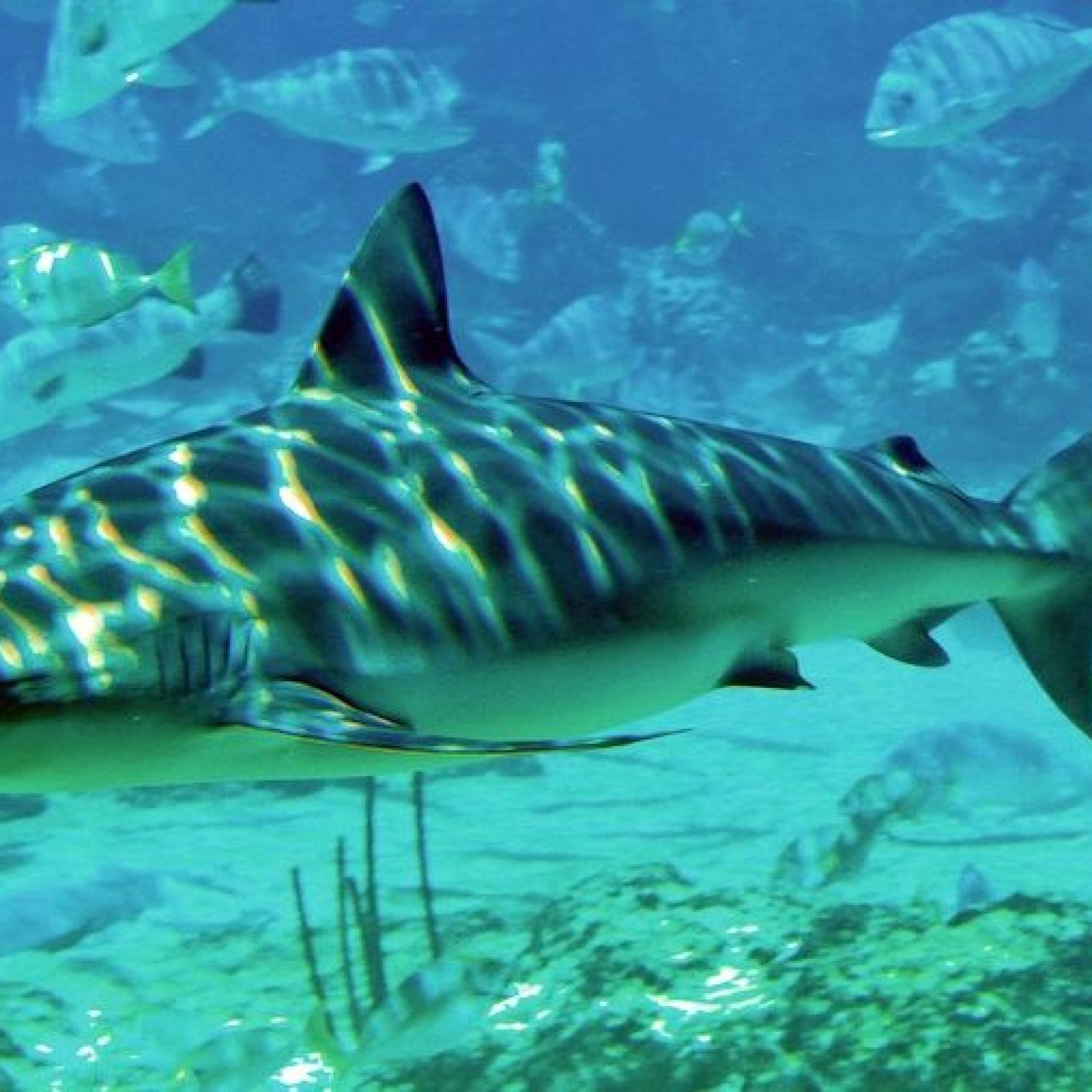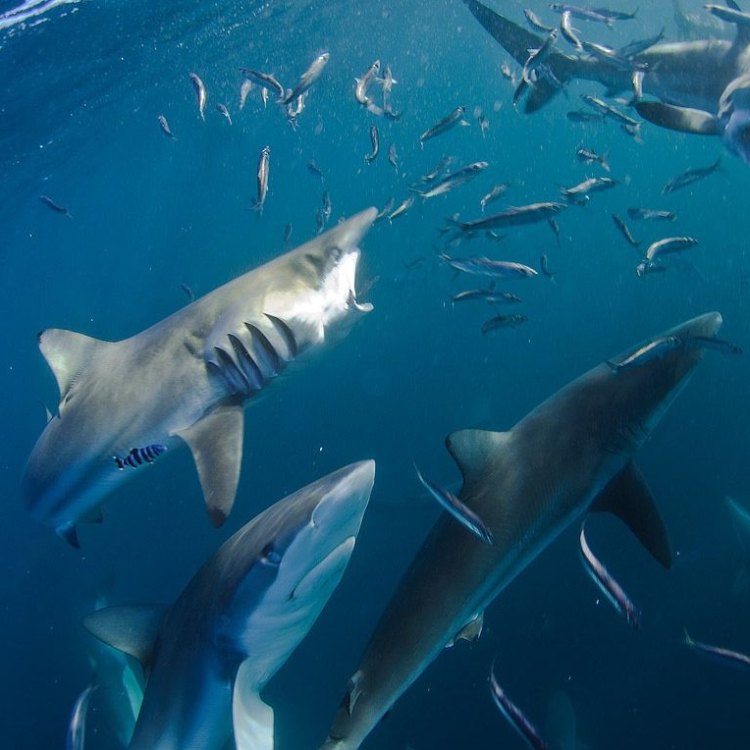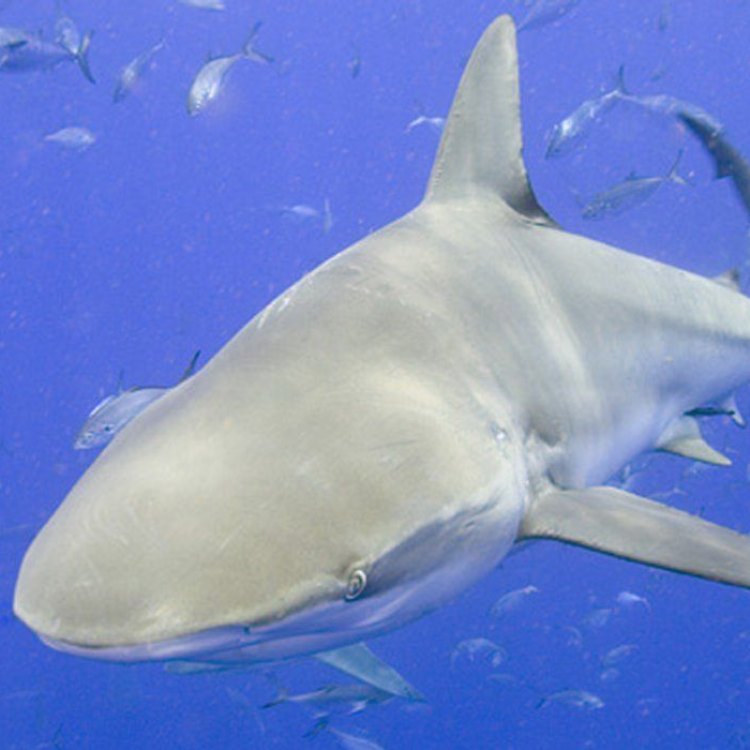
Dusky Shark
Up to 4.2 meters (14 feet)
Dusky sharks are large and sleek predators found in the Atlantic, Indian, and Pacific oceans. With an average length of 4.2 meters (14 feet), they are part of the Carcharhinidae family and have a slender, streamlined body shape. These majestic creatures are a sight to behold and play an important role in the ocean's ecosystem. Remember to always admire them from a safe distance and never disturb their natural habitat. #SharkAwareness #OceanConservation
Animal Details Summary:
Common Name: Dusky Shark
Kingdom: Animalia
Habitat: Coastal and offshore waters
Discover the Mysteries of the Dusky Shark: A Fierce Predator of the Seas
Underneath the crystal blue waters of the world's oceans lurk countless creatures, each with their unique behaviors, habitats, and abilities. One of these majestic animals is the Dusky Shark, a fierce predator that has captured the imagination of humans for centuries. Its dark, sleek body, swift movements, and sharp teeth make it a formidable presence in the waters it calls home.Known by its scientific name, Carcharhinus obscurus, the Dusky Shark is a member of the animal kingdom, in the phylum Chordata and class Chondrichthyes Dusky Shark. Its scientific classification also places it in the order Carcharhiniformes and the family Carcharhinidae, making it a distant relative of other well-known shark species such as the Great White and the Tiger Shark.
But what sets the Dusky Shark apart from its shark counterparts? What makes it a top predator in its underwater world? Let's dive deeper into the mysteries of this magnificent creature and unlock some of its incredible features.
Habitat and Distribution
The Dusky Shark is a highly adaptable species and can be found in a variety of habitats, from coastal to offshore waters. Its preferred areas include the continental shelves, reefs, and seamounts, where it can find an abundance of prey. These sharks can also be found in both tropical and warm-temperate waters worldwide, making them a truly global species.As these sharks are found in many waters, their exact country of origin is challenging to determine. However, they have been reported in various countries, including the United States, Brazil, South Africa, Australia, and Japan. The highest concentrations of Dusky Sharks are found in the Atlantic, Indian, and Pacific Oceans, making them a true world traveler.
Feeding Habits
Dusky Sharks are carnivorous predators, meaning they primarily feed on other animals Deinosuchus. They have a varied diet, and their food choices depend on factors such as location, season, and prey availability. Some common prey items for the Dusky Shark include small bony fish, squid, octopus, and crustaceans.The feeding methods of Dusky Sharks are as diverse as their habitat and distribution. They are opportunistic hunters and have been observed using different hunting techniques, such as ambush attacks, chasing after their prey, and scavenging. These sharks are also known to feed on larger marine mammals, making them top predators in their ecosystems.
Physical Characteristics
One look at a Dusky Shark, and it's easy to understand why it's often referred to as a "dark shark." These creatures have a distinctive dark gray to brownish-gray coloration on their back, with a pale white bottom side. This coloration allows them to blend in with their surrounding waters, making them harder to spot by their prey or potential predators.In terms of body shape, Dusky Sharks are slender and highly streamlined, giving them the ability to move swiftly through the water. This shape, combined with their powerful tail, helps them achieve impressive speeds when hunting their prey. They also have a unique feature known as a "nictitating membrane," a third eyelid that protects their eyes while hunting.
The average length of a Dusky Shark is around 3.2 meters (10 feet), with the largest recorded specimens reaching up to 4.2 meters (14 feet). They can weigh up to 350 kilograms (770 pounds), making them one of the largest shark species in the world.
Fascinating Behavior
For many years, sharks have been portrayed as fearsome and ruthless killers, but in reality, they are complex creatures with their unique behavior and social structures. Dusky Sharks are no exception, and researchers have observed many fascinating behaviors in these animals.One notable behavior is their habit of migrating. Dusky Sharks have been known to travel long distances, covering over 10,000 kilometers (6,200 miles) in one year. This impressive feat is due to their need to find new hunting grounds and breeding areas, as well as avoiding colder waters during the winter months.
Another interesting behavior is their ability to leap out of the water. Dusky Sharks have been observed jumping out of the water, reaching heights of up to 3 meters (10 feet). While the purpose of this behavior is still not entirely understood, it's believed that it could be a form of communication or a method of stunning their prey.
The Threat of Extinction
Despite their remarkable abilities, Dusky Sharks are not invincible. Like many shark species, they are facing threats to their survival, primarily due to human activities. Overfishing, habitat destruction, and pollution are the main culprits responsible for the decline in Dusky Shark populations.These sharks are also susceptible to getting caught unintentionally in fishing nets, known as bycatch. Such incidents can be devastating for the species, as they often result in injury or death. With their slow reproductive rate, it's challenging for Dusky Sharks to recover from any significant population decline.
Conservation Efforts
Fortunately, the decline of Dusky Sharks has not gone unnoticed, and many conservation efforts are being made to protect these creatures and their habitats. Various organizations are working towards implementing fisheries regulations and reducing bycatch to help prevent further population decline.Many countries have also designated certain areas as shark sanctuaries, where fishing for sharks is strictly prohibited. This measure aims to give these animals a safe space to thrive and maintain a healthy population.
Conclusion
As we continue to explore the oceans and unravel its many mysteries, the Dusky Shark remains a fascinating and vital part of this vast ecosystem. With its incredible abilities, unique behavior, and important role as a top predator, this animal deserves our admiration and protection.Through conservation efforts and responsible fishing practices, we can help ensure that these majestic creatures continue to roam the oceans for years to come. As we learn more about the Dusky Shark and other marine animals, let us also remember the importance of coexisting peacefully with the natural world. After all, we humans are just visitors in their vast, underwater kingdom.

Dusky Shark
Animal Details Dusky Shark - Scientific Name: Carcharhinus obscurus
- Category: Animals D
- Scientific Name: Carcharhinus obscurus
- Common Name: Dusky Shark
- Kingdom: Animalia
- Phylum: Chordata
- Class: Chondrichthyes
- Order: Carcharhiniformes
- Family: Carcharhinidae
- Habitat: Coastal and offshore waters
- Feeding Method: Carnivorous
- Geographical Distribution: Tropical and warm-temperate waters worldwide
- Country of Origin: Various countries
- Location: Atlantic Ocean, Indian Ocean, Pacific Ocean
- Animal Coloration: Dark gray to brownish-gray on the back with a pale white underside
- Body Shape: Slender and streamlined
- Length: Up to 4.2 meters (14 feet)

Dusky Shark
- Adult Size: Around 2.5 to 3.2 meters (8 to 10.5 feet)
- Average Lifespan: Around 30 to 40 years
- Reproduction: Viviparous
- Reproductive Behavior: Internal fertilization
- Sound or Call: No specific sound or call
- Migration Pattern: May undertake seasonal migrations
- Social Groups: Solitary
- Behavior: Nocturnal and mostly solitary
- Threats: Overfishing, habitat degradation, bycatch
- Conservation Status: Vulnerable
- Impact on Ecosystem: Top predator, helps maintain balance in marine ecosystems
- Human Use: Commercial fishing, sport fishing
- Distinctive Features: Long, slim body; broad, rounded snout; large, triangular teeth
- Interesting Facts: Dusky sharks are known for their impressive jumping ability
- Predator: Predatory fish and marine mammals

Carcharhinus obscurus
The Mighty Dusky Shark: A Top Predator of the Seas
The ocean is vast and mysterious, full of amazing creatures that are still waiting to be discovered. Among these creatures is the dusky shark, a formidable predator that dominates the food chain of the deep. With its impressive size and unique features, the dusky shark is a fascinating creature that deserves our attention. In this article, we will dive deep into the world of the dusky shark, learning about its physical characteristics, behavior, and impact on the ecosystem PeaceOfAnimals.Com.One of the most noticeable features of the dusky shark is its size. On average, an adult dusky shark can reach a length of 2.5 to 3.2 meters (8 to 10.5 feet). This makes it one of the larger species of shark, falling behind only the great white and tiger sharks in terms of size. It can also weigh as much as 300 to 400 kilograms (660 to 880 pounds), making it an intimidating presence in the ocean.
But size isn't the only impressive aspect of the dusky shark. This species also boasts a long lifespan of around 30 to 40 years Diamond Python. This is quite remarkable for a fish and is a result of their slow growth rate and late maturity. It is believed that females may not reach sexual maturity until they are 14 to 18 years old, while males reach maturity at around 12 to 16 years. This makes the dusky shark a long-living and slow-reproducing species.
Speaking of reproduction, the dusky shark is considered to be viviparous, meaning it gives birth to live young. Female dusky sharks have developed a unique reproductive behavior called internal fertilization. This means that the female's eggs are fertilized inside her body by the male's sperm, resulting in the development of embryos. The females will then give birth to anywhere from 6 to 14 pups after a gestation period of 16 to 18 months.
But what about communication? Do dusky sharks have any specific sound or call that they use to communicate with each other? The answer is no. Unlike some other shark species, the dusky shark is not known to produce any specific sound or call. This is because they are mostly solitary creatures and do not rely on communication for survival.
However, dusky sharks do exhibit some social behaviors. They are known to form small aggregations during migrations, but these are not considered lasting social groups. Dusky sharks are mostly nocturnal and prefer to hunt alone, making them well-suited for solitary life in the ocean.
Speaking of migration, the dusky shark is known to undertake seasonal migrations. These migrations are believed to be influenced by changes in water temperature and food availability. During these migrations, dusky sharks can travel long distances, sometimes crossing entire oceans. This demonstrates their impressive ability to adapt and navigate the vastness of the open ocean.
Unfortunately, the dusky shark is facing threats that may jeopardize its existence in the future. Overfishing is a major concern for this species, as they are often caught as bycatch in commercial fishing operations. This means that they are not being specifically targeted but are caught unintentionally while fishing for other species. This, coupled with habitat degradation, has resulted in a significant decline in dusky shark populations.
As a result, the dusky shark is currently listed as vulnerable on the International Union for Conservation of Nature (IUCN) Red List. This means that it is facing a high risk of extinction in the wild. This classification also reflects the urgent need for conservation efforts to protect this magnificent creature.
But why is the dusky shark so important to the marine ecosystem? As a top predator, it plays a crucial role in maintaining the balance of the ocean. Dusky sharks feed on a variety of prey species, including fish, crustaceans, and even other smaller sharks. By regulating the populations of these species, the dusky shark helps to prevent the overgrowth of certain species, which can have a cascading effect on the entire food chain.
Humans have also had a significant impact on dusky shark populations, but in a different way. This species has been commercially fished for its meat, fins, and oil, and is also targeted by sport fishermen. Its distinctive long, slim body; broad, rounded snout; and large, triangular teeth make it a challenging and prized catch for anglers. However, with a decline in dusky shark populations, it is essential to manage these activities sustainably to ensure the species' survival.
Aside from its role in the ecosystem, the dusky shark is also a fascinating creature with some interesting facts and features. One of the most impressive abilities of the dusky shark is its remarkable jumping ability. They are known for their acrobatic jumps, which can reach heights of up to 3 meters (10 feet) out of the water. This is often seen during feeding or when they are being chased by predators, and it is a remarkable display of their strength and agility.
But not all predators are larger and stronger than the dusky shark. They are also preyed upon by a variety of predatory fish and marine mammals, including killer whales, blue sharks, and even other larger shark species. This highlights the importance of maintaining a healthy population of dusky sharks to support the diverse marine ecosystem.
In conclusion, the dusky shark is a remarkable and essential species in the ocean. From its impressive size and longevity to its unique reproductive behavior and hunting abilities, the dusky shark is truly a marvel of the deep. Despite facing numerous threats, it continues to dominate the top of the marine food chain and plays a vital role in maintaining the balance of the ocean. It is up to us to ensure its survival, so future generations can also appreciate the beauty and importance of this amazing creature.

Discover the Mysteries of the Dusky Shark: A Fierce Predator of the Seas
Disclaimer: The content provided is for informational purposes only. We cannot guarantee the accuracy of the information on this page 100%. All information provided here may change without prior notice.












